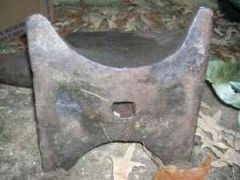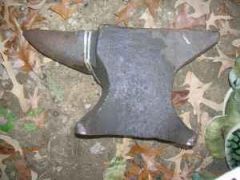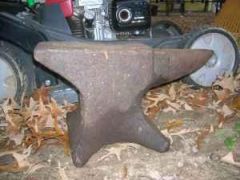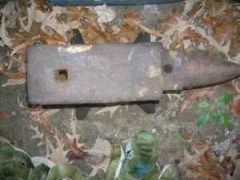
bajajoaquin
Members-
Posts
495 -
Joined
-
Last visited
Content Type
Profiles
Forums
Articles
Gallery
Downloads
Events
Everything posted by bajajoaquin
-
Abused Anvils As Source of Wrought Iron
bajajoaquin replied to bajajoaquin's topic in Anvils, Swage Blocks, and Mandrels
Interesting. I've never seen that thread. That's fantastic. Since so few people seem to be able to repair anvils these days, perhaps the best use of an abused anvil is to attempt to fix it, and learn. If it didn't work, you could still cut it up for scrap. -
Abused Anvils As Source of Wrought Iron
bajajoaquin replied to bajajoaquin's topic in Anvils, Swage Blocks, and Mandrels
By speaking in general terms, not about a specific anvil that has a starting bid if over a hundred bucks, for starters. -
russian cast steel aso
bajajoaquin replied to connor bachmann's topic in Anvils, Swage Blocks, and Mandrels
Although, if it's cast steel rather than cast iron, shouldn't he be able to either harden or hard face it? If he has more time than money, he could conceivably do a spark test to see if it's higher carbon than plain old mild steel. Couldn't he then heat and quench? Or, if he's got a friend who welds there might be an opportunity to add a layer of hard facing. Neither option is easy nor cheap. But if he hasn't found another anvil it might make his current substandard solution better. If course, if it's cast iron, there's no point in doing anything except looking for an anvil. --edited to fix typos from typing with my thumbs the first time.-- -
Abused Anvils As Source of Wrought Iron
bajajoaquin replied to bajajoaquin's topic in Anvils, Swage Blocks, and Mandrels
Aside from the fact that it sounds suspiciously like something Jeff Spicoli said in Fast Times at Ridgemont High, I'm curious to hear about this. How would he do it? Would he build up with rod and then hard-facing, or re-weld a plate on top? -
The abused Hay Budden thread reminded me of something that occurred to me recently. At the right price (perhaps around $0.25 a pound), is an abused anvil worth purchasing as a source of wrought iron? If you could get 100 or 150 pounds of wrought iron for $25 or $50 or so, would it be worth while? You could conceivably cut it up with a band saw, and have a pretty considerable amount of stock.
-
Electric resistance rivet heating
bajajoaquin replied to monstermetal's topic in Induction Heating, Oil forges, etc
It kind of looks like this is what's happening here. The shaft of the rivet is heating up faster than the broader head. Larry, can I ask a personal question? Why are you interested in this particular way of heating? Simple curiosity, or is there something specific that this may be applied to? -
Swage Block: How to Mill?
bajajoaquin replied to bajajoaquin's topic in Blacksmithing, General Discussion
I'm not going to bother. You guys convinced me back on page one. I was just responding to a "would have" type of scenario. Of course, having 250 pounds of steel blocks lying around, I'll just have to come up with something else irrational to do with them. -
Swage Block: How to Mill?
bajajoaquin replied to bajajoaquin's topic in Blacksmithing, General Discussion
That had been my idea before I got the mill. I was going to fasten them together, and drill holes, half on each block. But I didn't really need two swage blocks. An end mill should be able to mill both the half-rounds and the v-shapes. -
So there was this guy, and he and his dad were really good friends when he was a little kid. Like inseparable. The problem was that his father died when he was only 10. He became obsessed with the idea that he could go back in time and bring him back. So he read HG Wells's The Time Machine and looked for answers. He realized that there were no instructions on how to build a time machine in there. But he didn't give up. He looked into how time worked. He studied math. He studied physics. He got a PhD in physics, and he became a recognized authority in the field. He never gave up the idea that he could go back in time and see his dad again. As he worked on his "regular" research, he never stopped working on his time machine in secret. Finally, at one professional conference, he went out on a limb and presented his plans to make a time machine that would theoretically work, and transport a small object back in time. He didn't think anyone took him seriously, but after his presentation, another physicist, the leader in the field of time theory, came up to him and told him, "Your theory is sound, but it will never transport anything back past the point in time that the machine was created." So there he was. He had figured out how to make a time machine. But it was a lot more work, and didn't turn out quite how he expected. That's how this RR spike gun can be a success: accept that there's a lot more to it than forging a barrel, take the time to understand what you're really trying to accomplish, and work towards the goal. Pilots have a saying: you start out with an empty bag of experience and a full bag of luck. The trick is to fill the bag of experience before you empty the bag of luck. They, too, do something that can kill you. And by the way, that is a true story.
-
Swage Block: How to Mill?
bajajoaquin replied to bajajoaquin's topic in Blacksmithing, General Discussion
Hmm. I think you may have convinced me. Okay, I'll look at different projects formthe blocks. -
I wasn't sure where to put this, in Anvils, Machinery, or Problem Solving..... Anyway, as I've mentioned on other threads, I purchased three 85-lb steel blocks to fabricate an anvil while I was waiting to find a good commercial one. And I've found an anvil to buy. I thought about building a 270-lb anvil anyway, but I've also thought about using one or two for swage blocks. My available tools are angle grinders, 4X6 band saw, 1-hp drill press, and my bench horizontal mill. V-Cuts in the edges should be pretty straight-forward, as would be through-holes of varying diameters. The drill press will turn down to 180 rpm, and the mill gets down to 68 RPM, which my handy calculator says can hog out a 2-1/4" and 5-1/4" hole, respectively. So with some big drills and ball-end mills, I should be able to do pretty good-sized half-rounds and spherical depressions. So... Anyone have any feedback on where I can purchase reduced-shank large diameter end mills? Is this possible, or even advisable? Am I missing something else that I should consider?
-
Misc Steel Block and Plate
bajajoaquin replied to bajajoaquin's topic in Blacksmithing, General Discussion
Sorry, not unless I'm on my motorcycle. I'm in Point Loma (near downtown San Diego), but I'm headed up to Riverside to pick up my anvil and leg vise I won on eBay. I'm considering dropping by and grabbing one of the 5/8" plates from him on my way back. To make it more tempting for IFIers, I've got a 10 lb roll of hard-facing wire.... -
I bought three 85-lb steel blocks from this guy for my fabricated anvil (yes, still in the works...) and I'm kind of surprised he still has stuff left: My link The remaining blocks would make great Brazeal-type striking anvils, anvils for junkyard power hammers, or whatever. Also, he's got a few 4X8 plates, which would make for some solid fab tables (or a fantastic griddle!). Please help me out. I'm struggling not to buy any of it, but I'm sorely tempted. I'll be driving past there on Saturday, if anyone is interested, I can help deliver. Just get them off Craig's List, please!
-
I agree with Phil and Mark and Curly George. But I marked "dislike." Which doesn't mean I think they should be removed. After all, I dislike them for the very reason they're effective! I may not like them, but I like I Forge Iron, and it's a fair trade.
-
The enemy of good is better.
-
Just so that the images would still be around after the ad expired:
-
I just won this anvil last night on eBay. My link Time will tell if it's in as good of shape as he's claiming. At a little over $1 a pound, I though it was worth the risk. I also picked up his post vise in another auction. Looks like I'm driving up to Riverside this Saturday!
-
"Drawn Reciprocal Dingle Arm." That may replace the "portable stationary highbar crane" that I got from my grandfather.
-
The British only "won" the engagement by virtue of audacity. The Germans, without a strong naval tradition, didn't have the confidence to press home the battle. In actual fact, the German ships were able to keep firing after taking direct hits from British ships, whereas the Royal Navy's ships had inadequate armor and exploded and sank much more easily. The Germans made the tradeoff of slower speed and smaller armament but greater armor. Perhaps, in theory, had the British stood off further, they could have exploited the advantages of speed, but they didn't. The Germans lost fewer ships than the British. See Robert Massie's excellent Castles of Steel for greater detail. The Hood was designed as a battle cruiser, where speed was supposed to keep her out of the way of battleships. She was more lightly armored, and traded that reduced armor for speed. The problem was similar to the one with the British line-of-battle ships: unless you absolutely capitalized on the advantages of speed and maneuverability, you left yourself vulnerable to the enemy. The real issue may have been one of marketing: once you had "battle" in the name, and armed them with 15-in guns, you start thinking of it as a line-of-battle ship, and it just isn't. A tertiary issue is that technology advanced, and the next generation of battleships were as fast as the battle cruisers. But the initial trade-off is still there: speed for armor. She sank. The Bismark did not (at least not in that engagement). Your point about the Fairey Swordfish is interesting, since it is neither smaller, nor lighter than its replacements. It served out the war, and newer, faster aircraft didn't. (It's also interesting because of the parallel with Mitchell's demonstrations of bombs vs. aircraft, and the British experince with the Repulse and Prince of Wales in Singapore: the emergence of a new offensive technology requires defensive adaptation.) The Panther was also more heavily armored than the Sherman. Lighter, faster, more maneuverable than the Tiger, to be sure, but that just proves that heavier isn't always better. Same goes for the abomination of an armored gun that Porsche designed. It dwarfed the Tiger, and it was a useless piece of crap. Is a Hummer superior to an armored vehicle against IEDs? No. Was the cheap, light-weight Northrup F-5 superior to the expensive, heavy McDonnel F-4 in Air Force mock combat? Yes. So, in summary: The British won Jutland in spite of having inferior, faster ships, not because of it. Hood sank because of the initial compromise of armor/speed; superior ship design still gets sunk by airplanes. Sherman<Panther>Tiger. Speed and mobility aren't the defining characteristics, they are just one of the criteria that must be balanced against other needs in an overall determination of superiority. Getting back (kinda) to the topic at hand, the shield will illustrate this: A really light, paper-mache shield would be very maneuverable, but useless. A hard-faced steel shield capable of withstanding any blow of an opponent would be very protective, but also immobile and useless.
-
Sounds like you've been drinking the same kool-ade as the Royal Navy. They thought it was a good idea to trade armor for speed, and found out how well that worked at Jutland. They were left sweeping the battlefield mostly due to their long tradition of naval aggressiveness, but the German battleships were clearly superior and more battle-worthy. The HMS Hood didn't do so hot being faster than the Bismark, either. (Although I know I'm cheating a bit there, because the Hood was a battle cruiser, and not a battle ship. But since it sank in a direct exchange with the Bismark, the point still holds true.) Sherman tanks were much more mobile and faster than German armor, but fared poorly against them. The advantage the Soviet T-34 had was in it's sloped armor and 85 mm high-velocity gun. And volume. Quantity had a quality all its own. That's just two that come to mind. Speed and mobility are only decisive in some circumstances. edited to add: I just re-read, and this came off as incredibly smug and superior. Sorry. That wasn't my intent.
-
Neaves, the power feed is missing from the table, so I'll be turning knobs unless I come across one used. You don't still have parts for your Atlas, do you? Bob, I went to my local industrial surplus yesterday and picked up a handful of US-made end mills, and just ordered a set of MT2 holders. I'm thinking I'll buy the arbor next, and make my own support bar and end support.



